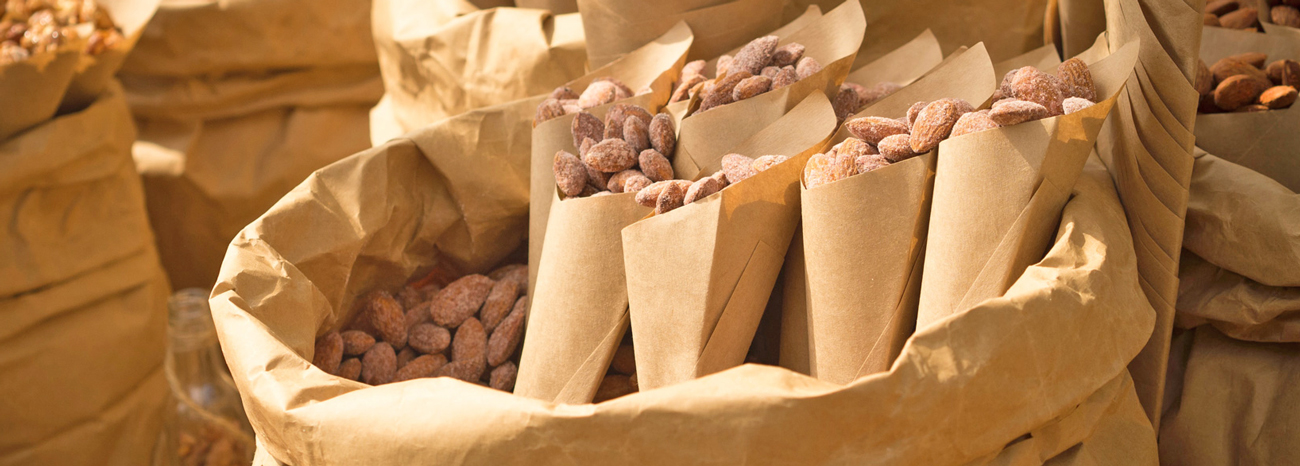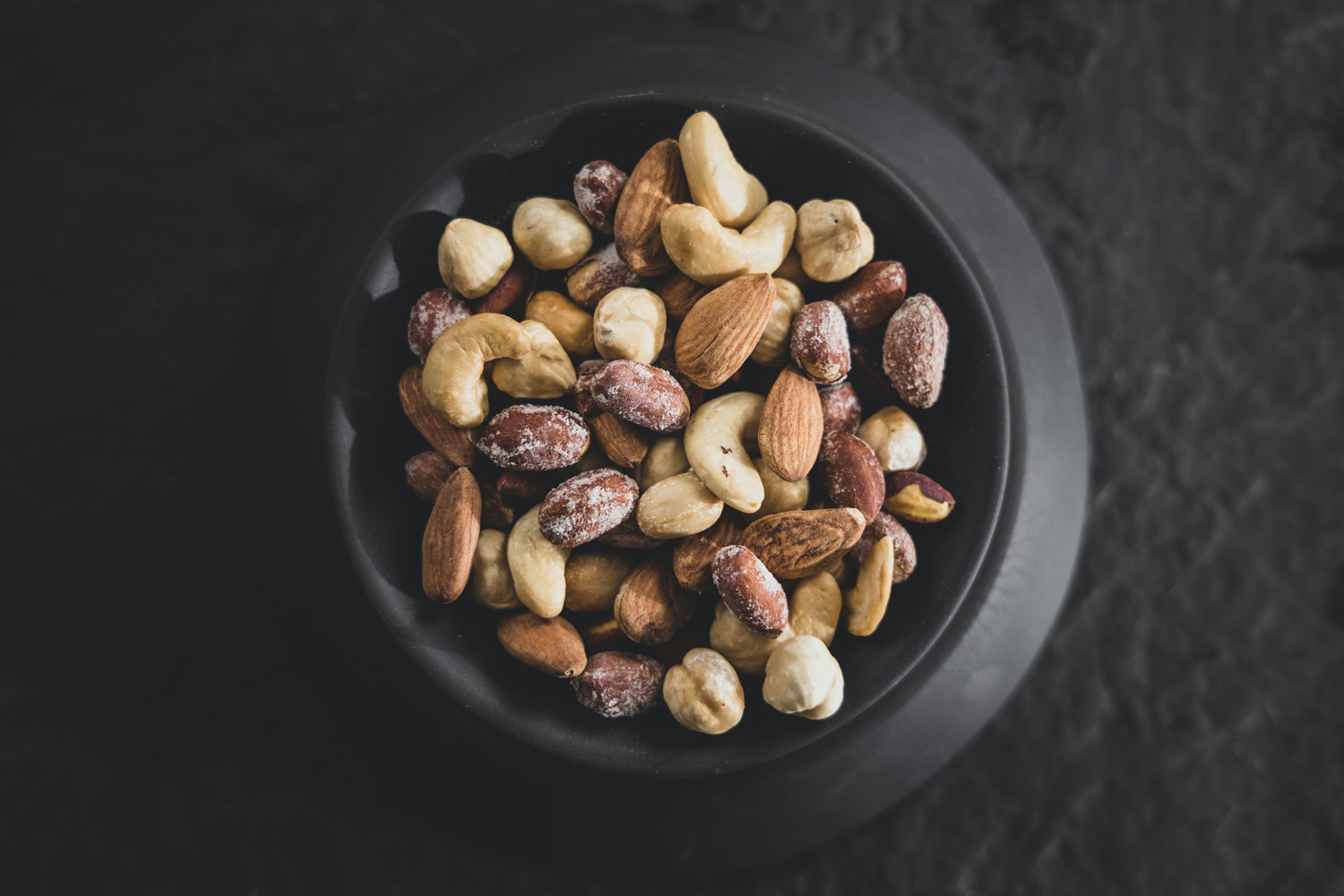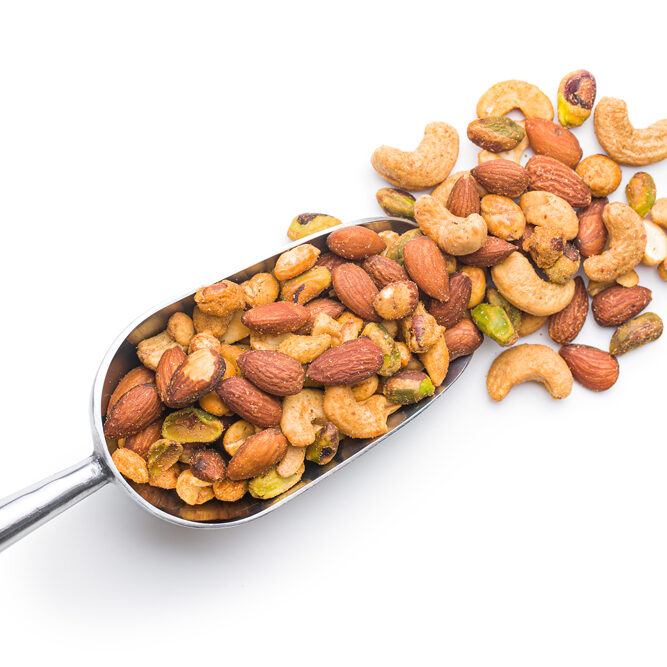

APPLICATION
Coating of nuts with a slurry, then roasted.
A dry-roasted nut is a nut delivering an extra crunch thanks to the addition of a relatively coarse and flavoured layer. The process is easy to implement in small pans and to scale up in large industrial lines.


BASE
Core products
The core is a nut – typically peanuts. Medium to large sizes are preferred, as a coating does not essentially increase the size of the nut. Nuts such as cashews and almonds are used in premium mixes.
RECIPE
Ingredients
The raw nuts are primarily coated with a slurry as glue.
This slurry is made of hydrocolloids which have swelling, filming, and adhesive properties such as:
- Gum arabic
- Pre-cooked starch
- Modified starch
- Natural swelling and filming ingredients
Then a flavoured powder mix is added. Again, the mixture is made of powders combining adhesive, filming, and flavouring properties:
- Salt
- Taste enhancers such as glutamate, yeast extract
- Heat-resistant flavour or ingredient developing flavour when exposed to heat
- Native flour or modified starch
Due to the extent of different ingredients, the flavoured mixes are usually supplied ready-to-use by specialist producers.






RECIPE
Ingredients
The raw nuts are primarily coated with a slurry as glue.
This slurry is made of hydrocolloids which have swelling, filming, and adhesive properties such as:
- Gum arabic
- Pre-cooked starch
- Modified starch
- Natural swelling and filming ingredients
Then a flavoured powder mix is added. Again, the mixture is made of powders combining adhesive, filming, and flavouring properties:
- Salt
- Taste enhancers such as glutamate, yeast extract
- Heat-resistant flavour or ingredient developing flavour when exposed to heat
- Native flour or modified starch
Due to the extent of different ingredients, the flavoured mixes are usually supplied ready-to-use by specialist producers.
PROCESS
How does it work?
It is a batch or continuous operation, depending on the size of the batch and flavour range.
The process may vary to obtain a specific aspect, such as Japanese-style snacks: after the biscuit forming and roasting, the nuts are coated with a starch solution.
After drying, it displays a shiny surface. Visible scan be included in or stuck with the answer: spices, herbs, algae. Due to the difficulty of handling a mass of liquid- and powder-coated products, the process is best run continuously. It allows for more even dispersion and roasting with lesser damage to the nuts.
Step 1.
Preparation of the slurry by dilution/heating of a powder in water (10 to 40 % dry ingredient, depending on the hydrocolloid).
Step 2.
Coating of the nuts with the fluid slurry.
Step 3.
Addition and coating on the wetted nuts with the flavoured powder mix.
Step 4.
Dry-roasting in an oven until a crispy layer develops on the nuts.
Step 5.
It is cooling before packaging.
PROCESS
Coating system
The successive liquid and powder applications can occur batch-wise or continuously. The slurry is dripped over the nuts and dispersed by the motion. The flavoured powder mix is dosed and spread with a vibrating scarf plate. As the powder tends to set quickly on the wet surface and form agglomerates, it is recommended to disperse the powder finely and progressively over the nuts. In a simplified version, the process applies to coating sunflowers seeds to obtain a favourite Spanish treat: the “Pipas.” The solution is a glue made of cooked starch, onto which salt is added before roasting.


PROCESS
Coating system
The successive liquid and powder applications occur in a pan or a continuous rotary tumbler or screw coater.
PRODUCT EVALUATION
How do you measure your success?
Key quality features
The product is a combination of features.


Core
Choice of standard or premium nuts to enhance the taste.
Coating
Crunchiness, heat-stable or developing flavour and colour combination, degree of roasting.
Operation
Limited nut fines, skin, coating residue, and lumps throughout the process.
Key quality parameters
Some aspects of this type of coating are critical.


Slurry
Viscosity (thickness) and filming property of the slurry.
Powder
The particle size of the powder enhances the adhesion without causing lumps.
Operation
Timely and quantitative control of the liquid and powder in additions to prevent excessive humidity or agglomeration roasting time and temperature profiles to remove moisture while preventing burning.
APPLICATION
Discover more applications

